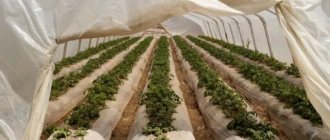Growing flowers is pure pleasure: aesthetic pleasure, light work and interesting experiments in breeding new beautiful hybrids. And the most simple one in this regard is the bulbous crop, which has thousands of varieties and species, and which invariably enjoys success during the most important holidays of the country. Do you dream of mastering the cultivation of tulips in a greenhouse on your own site? It’s not difficult - now we’ll look at all the subtleties and nuances of this business. Even the Russian State Agrarian University is preparing Dutch beauties for March 8. K.A. Timiryazev. They strive for the following result: beauty, maximum yield for a certain number of planted bulbs and long-term storage after cutting. And from this point of view, new varieties are selected, old ones are crossed and unusual hybrids are developed. Try it too – it’s an interesting and profitable hobby!
- 2 Where can I get bulbs?
- 3 Planning plantings - what needs to be taken into account?
- 4 How to prepare the soil and adjust the thermal regime?
- 5 What is a cooling period and why is it needed?
- 6 How to care for growing flowers?
- 7 How to properly harvest tulips?
Pros of a greenhouse
Growing tulips in a greenhouse is not a difficult task if you know the technology and strictly follow it. If you love these flowers and want to make money, then greenhouse growing is for you. If you like to tinker with flowers at all, breeding is something you can start with and make it your hobby.
This method of growing allows you to get flowers at any time of the year, and even just in time for the holidays, when they are traditionally in demand . In order to obtain beautiful and varied flowers, several conditions must be met. This is the choice of variety, planting material and compliance with the technology of growing tulips in a greenhouse.
Find out all about how to make a holiday bouquet varied and please your loved ones with fresh flowers from the greenhouse. We bring to your attention detailed materials on how to grow roses and chrysanthemums in a greenhouse.
Main features of our business
I will say right away that we started our business right away with large volumes - we grew a little over 40,000 tulips. To do this we had to install large greenhouses. If your initial appetites are smaller, then you won’t need a large starting capital. Please note that to force 2,000 bulbs you will have to build a greenhouse with an area of about 40 m2 - the territory of almost any household plot is quite suitable for this. A significant advantage of this is that to start running such a business you do not have to register it with the tax office. In our case, it all started on a large scale and we had to rent a large plot of land to conduct business, which we had to register.
However, I would like to immediately note that if a business is not registered, there is no possibility of selling goods to large commercial organizations. Actually, if your initial production volume is small, then this is not a problem at all.
The key to productivity is energy management: how to create your daily routine
Practicing Gratitude and Generosity: Changing Your Money Mindset
You should never take their word for it: how to work with sycophantic colleagues
Planting material
How to grow tulips in a greenhouse? To obtain strong, beautiful flowers, it is important to choose and prepare planting material . Where can I get the bulbs? Tulip bulbs are now sold in stores, nurseries, or simply by private individuals - gardeners who breed them.
The best time to buy bulbs is from July to mid-September. These are guaranteed to be the current year's bulbs . Moreover, the sooner you do this, the better quality planting material you will receive before it is taken apart by more efficient flower growers.
What to look for when buying bulbs:
- density and thickness of scales . If it is very dense and dark brown, this may be a sign that it has been left in the soil for too long;
- the ideal onion in diameter is 3.5-4 cm. You can take a slightly smaller size, but be sure to have a healthy onion;
- appearance. The bulb should be undamaged, without traces of mold, growing into the stem (only its small nose should stick out);
- condition of the lower part . There should only be tubercles from which roots will grow, the bottom should be dense;
- bulb weight. If the onion seems light for its size, it means it is rotten.
To avoid purchasing low-quality planting material, you can grow the bulbs yourself . It is best to take them from flowers growing in open ground. To do this, 2-3 days after the start of flowering, the blooming flowers need to be cut off.
Do not cut off the buds , this may stop the growth of the foliage and reduce the accumulation of necessary organic substances.
It is necessary to dig up the bulbs at the end of June - beginning of July, after 2/3 of the stem and leaves turn yellow. Only round-shaped bulbs measuring 3.5-4 cm in diameter are suitable for forcing (smaller sizes are acceptable).
Sort the onions by size: 1st analysis - the largest, 2nd analysis - smaller, etc. Peel them off to make sure they are healthy. In addition, the peeled ones receive more nutrients and moisture.
How to store bulbs?
The quality of future flowers depends on proper storage . In order for the organs to form in the bulb and the substances necessary for growth and subsequent flowering to accumulate, the bulbs are stored for the first month at a temperature of 20°C, then it can be reduced to 17°C.
Humidity is no less important than temperature; the bulbs should not dry out. Keep the level at least 70-75% . Containers should be ventilated, for example, boxes with a mesh bottom.
How much can you earn?
According to estimates by experienced flower growers, the cost of a tulip grown in a greenhouse is approximately 20 rubles. From one square meter you can get from 200 to 310 plants. And if you apply Dutch planting technology, the yield can reach 350 pieces. A small greenhouse area of 12 square meters will allow you to collect at least 2400 flowers. On holidays, the retail price varies from 50 to 70 rubles, and the wholesale price ranges from 40 rubles. By selling flowers wholesale, you can get 96,000 rubles. Taking into account the cost of production, the income will be 48,000 rubles. Obviously, growing tulips is a very profitable business.
Planting for forcing
How to grow tulips in a greenhouse? Before planting, the bulbs should be kept at a temperature of +9°C for two weeks. Peel the onions to give maximum access to nutrients. If there is a lot of planting material, clean only the root tubercles.
To prevent possible infections, the bulbs need to be treated before planting. For disinfection, simply hot water can be used, but not more than 40°C . A solution of potassium permanganate (weak) or a decoction of celandine is also suitable.
The substrate is poured into the planting containers in a layer of at least 10 cm. The bulbs are buried 3-4 cm with light pressure and covered with substrate on top.
The tulip is remarkable in that it does not require powerful lighting . The planting density can be 250-300 pieces per 1 square meter. m. Planting can begin from the end of August. Its time depends on the date by which you want to receive blooming tulips.
The soil
The traditional substrate for tulips is a mixture of sand (river) and sawdust. Flowers are quite tolerant of a lack of nutrients, but do not tolerate excess moisture at all. Therefore, the soil must be well drained. To disinfect it, it would be a good idea to steam it at 80°C and spray it with a fungicide. The acidity of the soil should be neutral.
Cooling
Containers with planted bulbs are kept at a temperature of 7-9°C for 13-20 weeks.
Cooling is necessary for rooting , shoot growth and accumulation of the substance responsible for stem growth. By the end of cooling, the plant should produce a stem 5-7 cm tall.
During this time, the seedlings are watered, and the desired humidity level is established in the room. To maintain a high level of humidity in the greenhouse, you need to water the floor and walls twice a week. During cooling, lighting should be minimal , it is best to keep the room dark.
About the sale of goods
The most difficult thing in our business is selling goods. I’ll tell you right away that selling 2,000 tulips a couple of days before the holiday is a rather difficult task even for a large city, let alone small settlements. That is why you should look for buyers in advance, and it is best to negotiate a wholesale supply.
Flowers can be offered both in person and through social networks, and sales can be negotiated on the market.
Forcing tulips
The cooling period is over, the actual distillation begins.
Temperature
How to drive out tulips in a greenhouse? Begin to gradually raise the temperature in the greenhouse. For several days it should remain at 12-14°C, then increase to 16-18°C during the day and 14-15°C at night. When the buds appear, you need to reduce the temperature to 15°C . This will make their color more saturated, the stems stronger and longer. If you need to speed up flowering by 2-3 days, you can increase the temperature to 20°C.
Lighting
During the first days of forcing, there is no need for much lighting. With a sprout height of 6-7 cm, the lower illumination threshold will be 900 lux. In February, tulips need to extend daylight hours to 10-12 hours with the help of phytolamps placed half a meter above the plantings.
Watering
Plantings are watered early in the morning every day. Use cold water (+8-12°C). Melt water containing a minimum amount of impurities is very good. Avoid getting water on the leaves. During the first week, regular watering can be alternated with a solution of calcium nitrate (0.2%).
Top dressing
The forcing period is too short to fully fertilize the soil - it will not have time to be absorbed. You can feed it a couple of times with a special liquid fertilizer for bulbous plants.
Forcing tulips in a greenhouse by March 8
How to grow tulips in a greenhouse by March 8? If you grow tulips in a greenhouse, it would be a shame not to have them bloom in time for the “tulip” holiday itself – March 8th. For beginners, growing tulips in a greenhouse by March 8th is the first serious test of being on time.
It is necessary to time the bookmark in time . How long do tulips grow in a greenhouse? Calculating the time for laying bulbs for cooling is simple. You need to cut flowers on March 7th. Subtract 21 days from this date - this is the time of growth in the greenhouse, and again subtract 16 weeks from the resulting date - the time of cooling and germination of the bulbs. As a result, it turns out that you need to plant the bulbs on October 26th .
What is a cooling-off period and why is it needed?
A relatively short cold period and bright lighting will help to grow such flowers. As soon as the cold period ends, place the pots with bulbs in the greenhouse. There must be enough light in it - this is a prerequisite. Once placed, water well and always try to keep the soil moist. But only in wet conditions - with a deficiency or excess, the work of the roots will deteriorate significantly, and the flower may dry out. By the way, you can cool the bulbs in a regular home refrigerator - just dry them well first.
The cooling period is very important - this is the key to high similarity.
How to cut?
Cutting tulips, it turns out, is not such a simple matter . The further development of the bulb, which will be used as planting material for the next season, depends on it.
If you cut too low and do not leave enough leaves, this will affect the accumulation of necessary mineral salts for the further development of the flower.
The bulb shreds and becomes unsuitable as planting material. For cut tulips, it is better to take varieties with a long stem . If the issue of planting material is not an issue at all, then it is better to pull out the plant along with the bulb.
A bouquet of tulips in a vase with whole, well-washed bulbs is now considered a fashionable design move. Needless to say, this will significantly extend the life of cut flowers .
Where can I get bulbs?
For a long time now, flowers have been growing in greenhouses only from Dutch bulbs - producing your own in Russia is both labor-intensive and not profitable. You can order Dutch bulbs via the Internet - and they arrive in our country via rail. In Soviet times, however, such a supply could be made from the Baltic states, but today only the Rostov region is engaged in such business in Russia, which does not yet provide the required assortment for large flower greenhouses. At the same time, they are grown both in America and New Zealand, but only in Holland have world auctions been concentrated for many decades, from where the bulbs and the flowers themselves end up in various parts of the world. Moreover, tulips in this country are very cheap - but transporting them to Russia is extremely problematic due to inconvenient transportation: only exclusive hard varieties survive.
Variety selection
Varieties of tulips for forcing are selected depending on the required flowering time and purpose - for breeding or for sale .
There are varieties of early, medium and late forcing. Recommended varieties for early forcing (late December), simple early class:
- Abba;
- Primavera;
- Zorro;
- Apricot beauty;
- Sunrise;
- Christmas Marvel.
For the average forcing ( from February 14 to 23 ), Triumph class:
- Kiss Nellys;
- Carola;
- Yearning;
- Abu Hassan;
- Gander.
For late forcing, varieties from the class of Darwin hybrids are recommended ( by March 8 ):
- Carnaval de Nice;
- Aristocrat;
- Parade;
- Davenport;
- Flaming Parrot.
In fact, there are a huge number of varieties ; you can choose the most beautiful ones from catalogs with descriptions.
Problems during cultivation
Problems in forcing can arise if its rules .
- The buds look like paper. Reduce the temperature and ventilate the greenhouse regularly.
- Drooping flowers indicate too high a temperature.
- Weak peduncles - night temperature exceeds daytime, lack of calcium.
- Poor rooting of bulbs - too low humidity .
- Bulbs rotting after planting - soil that is too warm.
- Pasture only a leaf without a peduncle - the bulbs are planted too small.











